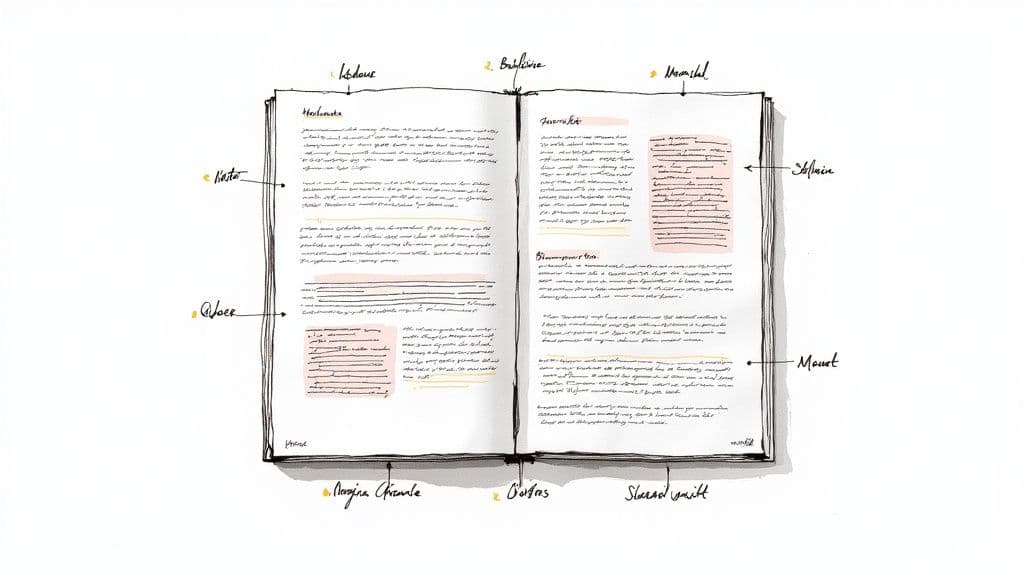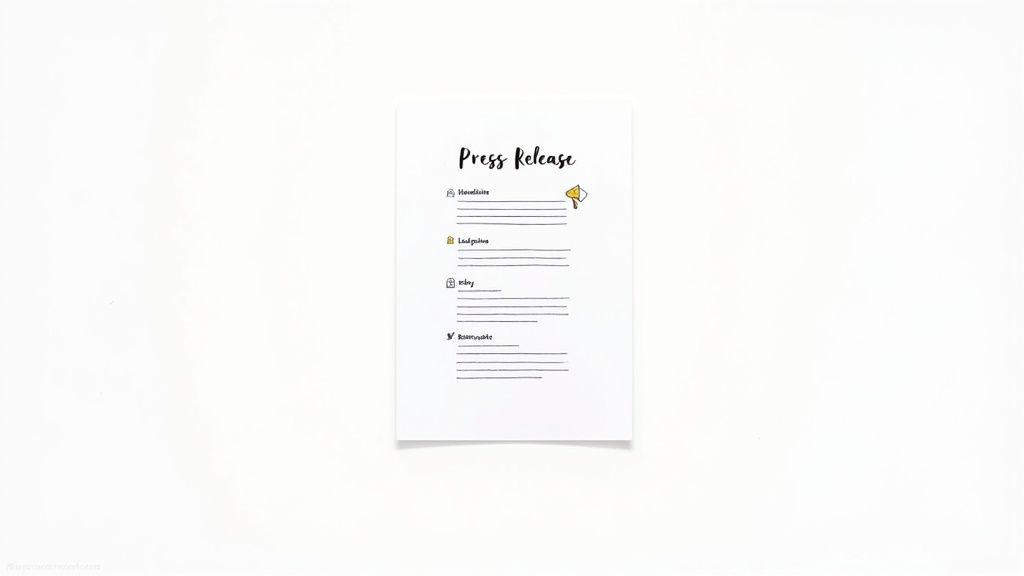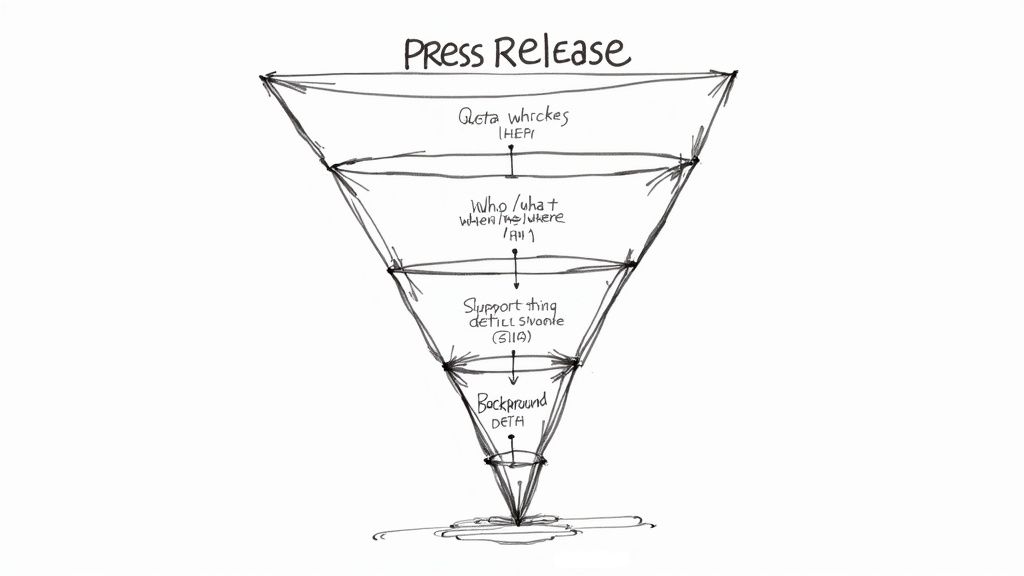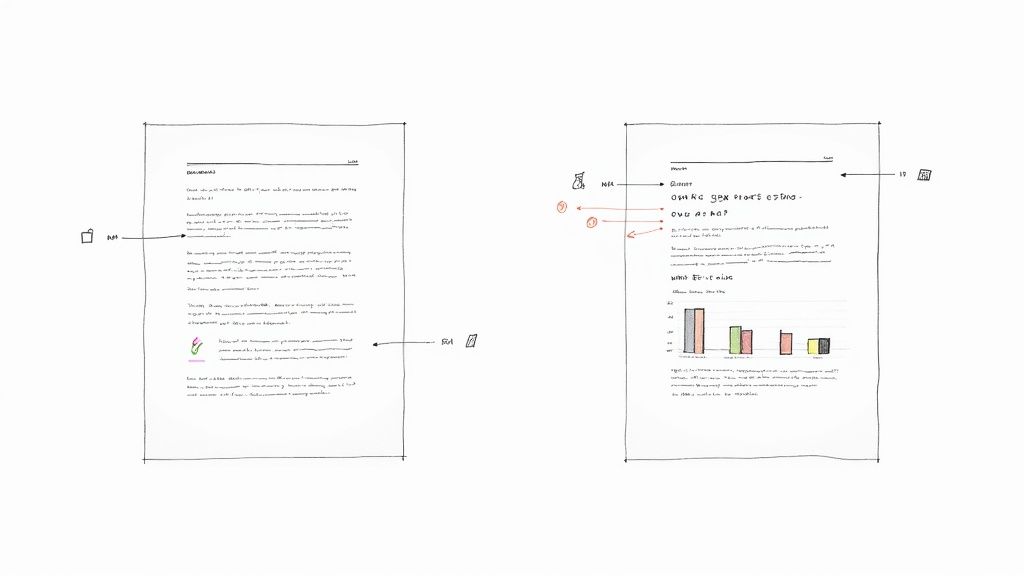What Does a Press Release Look Like? A Complete Guide
November 6, 2025

At its heart, a press release is a news story written for journalists, not the general public. It follows a strict, universally recognized format for a very good reason: speed. Reporters are busy people, and this structure lets them instantly size up your announcement and decide if it’s newsworthy.
The format includes a can't-miss headline, a dateline, an intro that gets right to the point, and body paragraphs that add important details. It wraps up with some company background and, most importantly, who to contact for more information.
The Essential Structure of a Modern Press Release
Before you even think about writing, you need to understand the blueprint journalists know and expect. A press release isn't just a wall of text; it's a carefully assembled document built for clarity and efficiency. Think of it as a universal language that tells a reporter exactly what they need to know, right where they expect to find it.
This diagram breaks down the basic anatomy of a press release, showing how the information flows from the most critical facts at the top down to the supporting details.

As you can see, the structure is deliberately top-heavy. The main point is delivered immediately, so there’s no guesswork. Getting this layout right is the first—and most important—step to crafting a release that journalists will actually read.
Key Components of a Press Release
So, what does a press release really look like up close? Let's break down the individual parts. Each section has a specific job to do, and they all work together to create a professional and compelling announcement.
Here’s a look at what every standard press release needs:
- Headline and Sub-headline: This is your first and only chance to make an impression. It needs to grab attention and summarize the entire story in a single, powerful line.
- Dateline: This simply includes the city, state, and date of the release. It grounds your news in a specific time and place, giving it immediate context.
- Introduction (Lede Paragraph): The all-important opening paragraph. It must answer the who, what, when, where, and why of your story right away. No fluff.
- Body Paragraphs: Here’s where you add the supporting details. This is the place for statistics, compelling quotes from key people, and any other context that fleshes out the story.
- Boilerplate: A brief, standardized "About Us" paragraph at the end that gives journalists some background on your organization.
- Media Contact Information: Absolutely essential. Provide the name, email, and phone number for the person journalists should contact for follow-up questions or interviews.
- "###" Symbol: This is a classic journalism signal. Placing three hash marks, centered, on a line by themselves at the very end indicates the conclusion of the release.
A well-structured press release is like handing a journalist a story kit on a silver platter. By giving them all the pieces in the right order, you make their job easier and dramatically boost your chances of getting coverage.
To make this even clearer, here’s a quick-reference table summarizing the key parts of a press release and what they do.
Quick Guide to Press Release Components
| Component | Purpose and Key Information |
|---|---|
| Headline | Grabs attention and summarizes the core news. Should be concise and impactful. |
| Dateline | States the city, state, and date of release (e.g., "NEW YORK, NY – October 26, 2023"). |
| Introduction (Lede) | The first paragraph. It must answer the 5 Ws (Who, What, When, Where, Why) immediately. |
| Body | Provides supporting details, quotes from key figures, relevant data, and context to flesh out the story. |
| Boilerplate | A short, standardized "About Us" section that provides background on your company or organization. |
| Media Contact | Lists the name, title, email, and phone number of the person a journalist can contact for more information. |
| ### | A centered symbol on the final line that signifies the end of the press release content. |
Keep this table handy as you start building your own releases. Mastering this format is the foundation for getting your news noticed.
Crafting a Headline That Earns the Click

Let's be blunt: your headline is the most critical part of your press release. It’s not just a title; it's your one shot at grabbing the attention of a journalist drowning in hundreds of emails. If it doesn't scream "newsworthy" in a split second, your announcement is heading straight for the trash folder.
Think of it as the ultimate email subject line. A vague, lazy headline like "Company Announces New Initiative" is dead on arrival. A great headline, on the other hand, tells the core story at a glance. It's punchy, uses active verbs, and gets straight to the point.
The difference is night and day. Compare these:
- Weak: "Starbucks Updates Store Portfolio"
- Strong: "Starbucks to Close Approximately 200 Stores, Citing Shift in Customer Experience Strategy"
See what I mean? The second one is loaded with specifics—an impactful number and the "why" behind the news. It makes a reporter curious, and that's the whole game.
The Power Trio: Headline, Sub-headline, and Dateline
While your main headline does the heavy lifting, a couple of other key pieces set the stage and add a layer of professionalism. When you think about what a press release looks like to a seasoned journalist, this introductory block is what they scan first. It needs to be perfect.
First up, the dateline. This is non-negotiable. It’s a simple line that precedes the first paragraph and includes the city, state, and full date of your announcement (e.g., SEATTLE, WA – September 25, 2025). This small detail instantly grounds your news in a specific time and place, adding a crucial touch of authenticity.
Next, you have the option of a sub-headline. This is a secondary, often italicized line that fleshes out the main headline. It's the perfect spot to drop a key statistic or a compelling detail that didn't quite fit in the main event.
Your headline makes a promise. The sub-headline and the very first sentence of your press release need to deliver on that promise immediately by giving the reader the most important information right away.
Putting It All Together
So, how do all these elements work in concert? A well-structured opening is a one-two-three punch of clarity and intrigue that pulls the journalist right into your story.
Here's how that looks in practice:
- Headline: Tech Innovator AeroSynth Unveils First AI-Powered Drone for Urban Farming
- Sub-headline: New "Agri-Drone" Boosts Crop Yields by 30% in Pilot Program, Slashing Water Usage by Half
- Dateline: SAN FRANCISCO, CA – October 26, 2025
This combination tells a complete mini-story before the journalist has even read the first paragraph. The headline delivers the "what," the sub-headline provides the "why it matters" with hard data, and the dateline lends it credibility. Get this formula right, and you've won half the battle.
For more ideas, check out these powerful press release headline examples to see what gets the media's attention.
Building the Narrative with a Strong Introduction and Body
A great headline gets you the click, but the introduction is what buys you a journalist's time. This crucial first paragraph, known in the industry as the lede, has one job: get straight to the point and deliver on the promise of your headline. This isn't the time for a slow, creative wind-up; it's for the hard facts, right upfront.
The classic, time-tested way to nail this is with the inverted pyramid. Think of an upside-down triangle. All the must-know, critical information sits in that wide top section. As you move down the release, the details become more supportive and less essential, just like the narrowing point of the triangle.
Your first paragraph absolutely must answer the five Ws:
- Who is this story about?
- What is the actual news?
- When is this happening?
- Where is it taking place?
- Why does this matter to anyone?
By front-loading your release this way, you hand a busy reporter the entire essence of the story in seconds. It shows you respect their time and makes it incredibly easy for them to decide if your announcement is a fit for their audience.
Fleshing Out the Story in the Body
With the essential facts established, the body paragraphs are your chance to add color, context, and credibility. This is where you build on your opening statements and create a compelling narrative that pulls the reader in. Each paragraph should add a new layer, moving the story forward.
One of the most powerful tools here is a great quote. A well-placed quote from a key person—a CEO, a founder, or a subject matter expert—injects a human element. It gives journalists a soundbite they can lift directly for their article, adding a voice and a unique perspective.
A strong quote offers an opinion or insight; it shouldn't just rehash facts you've already stated. Think of it as the personality of your story.
After the quote, it's time to back up your claims. Bring in specific data points, compelling statistics, or any background information that reinforces why your news is a big deal. The goal is to give a journalist enough material to write a solid story without sending them on a scavenger hunt for basic facts. To really understand what gets journalists excited, check out our guide on what makes a story newsworthy.
Keeping It Concise and Professional
As you build out the body, remember that every word counts. You’re adding detail, but you still need to be concise. Every sentence has to earn its spot. Industry data shows that the sweet spot for a press release is between 300 and 500 words. That’s enough space to be thorough without overwhelming a busy editor.
Ultimately, the body of your press release is where you build the case for your news. By layering in supporting facts, expert quotes, and hard data, you transform a simple announcement into a story lead that a journalist can actually use. You're showing them, not just telling them, why this matters.
The Final Touches: Nailing Your Press Release Formatting
You've built a compelling story, but now it's time for the final, crucial step: formatting. This isn't just about making things look nice; it's about showing you understand the unwritten rules of the industry. The right format signals professionalism and respect for a journalist's time.
Think of it like dressing for a big job interview. You wouldn't show up in a t-shirt and shorts. The same principle applies here. Clean fonts like Times New Roman or Arial, standard 1.5 or double spacing, and including the universally recognized end marker are the equivalent of a well-pressed suit. They show you're serious and you know the game.

Adding Your Boilerplate and Contact Info
Tucked away at the bottom of the release are two pieces of information that are anything but an afterthought: the boilerplate and your media contact details. They provide vital context and, more importantly, a direct line for journalists to get in touch.
Your boilerplate is essentially your company's "About Us" section, condensed into a sharp, standardized paragraph. It should instantly tell a reporter:
- Who your company is.
- What you do or what your mission is.
- Where you're based and the markets you operate in.
This little blurb gives journalists the background they need on your organization without making them hunt for it.
Right after the boilerplate comes your media contact information. This part has to be crystal clear and accurate. It’s the journalist's direct path to you for follow-up questions, interview requests, or a quick clarification. A typo here could mean a missed opportunity.
Think of your boilerplate as your company’s elevator pitch and the media contact section as your digital business card. Both need to be polished and easy to find to make a journalist’s job easier.
Make sure a reporter can reach you without any friction. Always include:
- Name: The full name of the person they should contact.
- Title: Their job title at the company.
- Email: A direct email that is actively monitored.
- Phone Number: A direct line or cell number is best for urgent requests.
Seeing how these elements come together visually can be a huge help. This press release format sample provides a great blueprint for putting it all into practice.
The Finishing Flourish: The Three Hashtags
And now for the very last thing. Your press release should always end with a simple, yet non-negotiable, symbol: ###.
This trio of hashtags is always centered on its own line, right after your contact information. It’s a classic, old-school journalism tradition that signals "the end." It definitively tells the reader that there's nothing more to the story, preventing any confusion. It’s a small detail, but it’s one of the clearest ways to show you speak the language of the media.
Breaking Down Real-World Press Release Examples
Theory is great, but seeing how all the pieces fit together in the real world is where it all clicks. The fastest way to get a feel for what works is to look at actual press releases from different industries. It’s how we move from just knowing the rules to understanding the game.
Let's dissect two common but very different types of announcements. First, we’ll look at a classic product launch, which is all about crafting a compelling story and using great quotes. Then, we'll shift gears to a data-driven report, which shows how to turn statistics and multimedia into a story that reporters can't ignore.
Example 1: The Classic Product Launch
We'll start with a hypothetical product launch from a tech company called "Innovate Robotics." This example is built to show you the core structure and narrative flow that makes a launch announcement land with impact.
FOR IMMEDIATE RELEASE
Innovate Robotics Unveils 'Guardian,' the First AI-Powered Home Security Drone
New Autonomous Drone Offers 24/7 Property Surveillance, Smart Threat Detection, and Real-Time Mobile Alerts, Setting a New Standard in Residential Safety
AUSTIN, TX – October 26, 2025 – Innovate Robotics today announced the launch of Guardian, an autonomous AI-powered home security drone. Designed to proactively monitor residential properties, Guardian uses advanced sensor technology and machine learning to identify and deter potential threats before they escalate, offering homeowners unprecedented peace of mind.
"For too long, home security has been reactive," said CEO Amelia Chen. "Guardian changes that. We're not just recording break-ins; we're preventing them. Our mission is to give families a sense of true security, and this drone is a massive step forward in achieving that."
The Guardian drone integrates seamlessly with existing smart home systems. It can perform automated patrols, investigate unusual sounds or motion, and stream high-definition video directly to a user's smartphone. In a recent study, homes equipped with Guardian saw a 60% reduction in trespassing incidents compared to homes with traditional camera systems.
Key Takeaways From This Example
This press release is effective because it plays by the rules perfectly. It gives a busy journalist everything they need, exactly where they expect to find it.
- Powerful Headline & Sub-headline: The headline gets straight to the point (new product!), while the sub-headline sells the "why" by listing exciting features and benefits.
- Strong Inverted Pyramid: The first paragraph is a masterclass in efficiency. It nails the who, what, when, where, and why right away. A reporter gets the entire story in seconds.
- Impactful Quote: The CEO’s quote isn’t just a dry statement of fact. It sells a vision and adds a human touch, making it incredibly easy for a journalist to copy and paste right into an article.
- Data-Backed Claims: That 60% reduction statistic is pure gold. It adds a layer of credibility that a simple claim could never achieve and gives the story some real teeth.
Example 2: The Modern Data-Driven Report
Now for a completely different angle. This example from a fictional research firm, "Urban Analytics Group," centers on new data. This is an incredibly effective strategy for earning media coverage because journalists are always hungry for fresh statistics to build stories around.
FOR IMMEDIATE RELEASE
New Report Reveals Remote Work Has Permanently Reshaped Downtown Commercial Real Estate
Urban Analytics Group's 2025 "Future of the City" Study Finds a 40% Increase in Vacant Office Space and a Surge in Demand for Mixed-Use Developments
CHICAGO, IL – October 26, 2025 – Urban Analytics Group today released its annual "Future of the City" report, a comprehensive study revealing a permanent and dramatic shift in commercial real estate trends driven by the persistence of remote work. The report finds that major metropolitan downtowns are experiencing a 40% increase in office vacancy rates since 2020, while demand for flexible, mixed-use residential and retail spaces has surged by 25% in the same period.
"The data is clear: the five-day, in-office work week is no longer the standard, and our city centers must adapt or face economic stagnation," stated lead researcher Dr. David Reed. "This isn't a temporary dip; it's a fundamental restructuring of urban life."
The full report, including detailed infographics and city-by-city data, is available for download at UrbanAnalyticsGroup.com/report-2025. The study surveyed over 5,000 businesses and analyzed real estate data from 20 major U.S. cities.
This release shows you how to build a story around pure information. By leading with a jaw-dropping statistic, it hooks the reader immediately. The inclusion of a direct link to the full report and a sharp quote from an expert positions Urban Analytics Group as a thought leader, making it incredibly simple for a journalist to write a detailed, data-rich article.
Before you hit send on your own masterpiece, it’s always a good idea to run through a final checklist. This simple step can be the difference between getting noticed and getting ignored.
Press Release Format Checklist
This table breaks down the essential structural and formatting elements. Give it a quick scan to make sure you've ticked all the boxes.
| Element | Checklist Item | Best Practice |
|---|---|---|
| Header | Is "FOR IMMEDIATE RELEASE" clearly stated? | Placed at the very top, left-aligned, in all caps. |
| Headline | Is the headline compelling and in Title Case? | Keep it under 100 characters and focus on the core news. |
| Sub-headline | Does the sub-headline add context and use sentence case? | It should expand on the headline with key details or benefits. |
| Dateline | Is the CITY, STATE – Month Day, Year – format correct? | Example: AUSTIN, TX – October 26, 2025 – |
| Introduction | Does the first paragraph cover the 5 Ws? | Who, what, when, where, and why should be answered immediately. |
| Body Paragraphs | Is supporting information included (quotes, data)? | Add context, credibility, and human interest. |
| Boilerplate | Is your standard "About Us" section included? | A brief, consistent paragraph about your organization. |
| Media Contact | Are the contact person's details clear and complete? | Include Name, Title, Email, and Phone Number. |
| End Mark | Is the release concluded with "###"? | A centered ### signals the end of the press release. |
A quick review using this checklist helps ensure your announcement is professional, easy for journalists to parse, and ready to make an impact.
Your Press Release in the Digital Age: Getting Found and Getting Seen

A modern press release has to pull double duty. It's not enough for it to just land in a journalist's inbox anymore. It needs to be a hard-working asset that can hold its own in search engine results, pop up in social media feeds, and look great in a digital newsroom.
The days of the simple, text-only document are long gone. Today, a great press release is a full-blown multimedia package, built from the ground up to be discovered and shared.
This means you have to put on your digital marketing hat. The classic structure is still your foundation, but you need to layer in the elements that help your news travel online. When you think about what a press release looks like now, you have to consider its entire life cycle—where keywords, links, and visuals are just as critical as the core message itself.
Weaving in Keywords for Search Visibility
If you want your announcement to be found weeks or even months after you send it, you have to think about Search Engine Optimization (SEO). It all starts with figuring out the specific keywords your audience—journalists, customers, investors—would actually type into a search bar.
So, instead of a generic announcement about a "new software update," you might target a more specific, searchable phrase like "AI-powered logistics software for e-commerce."
By weaving these terms naturally into your headline, your sub-headline, and the first paragraph, you dramatically increase the odds of your release showing up on Google. This simple shift turns your press release from a one-day event into a lasting piece of content that can keep pulling in traffic and leads.
The Power of Links and Multimedia
Let's be honest: a giant wall of text is an instant turn-off. The most effective press releases today use rich media to tell a more compelling and shareable story.
A press release with images gets significantly more views than one without. Visuals don't just support the story—for a busy journalist on a tight deadline, they often are the story.
Here’s how you can make your release stand out:
- Embed High-Quality Images: Always include professional headshots, crisp product photos, or clear infographics directly in the release.
- Link to Video Content: Add links to product demos, interviews, or company overview videos. Hosting them on platforms like YouTube or Vimeo makes them easy to watch and embed.
- Use Strategic Hyperlinks: Don't just mention your company; link its name to your homepage. When you cite a statistic, link directly to the original report. This builds credibility and sends traffic where you want it to go.
By 2025, the whole game of distributing and consuming press releases is being reshaped by technology, particularly AI and digital media. Releases are now built not just for media pickup but to perform well in search and on social channels. As experts point out, smart distribution is key—using AI to get the right content in front of the right people. You can learn more about the future of PR distribution and how it's adapting. This all lines up with how we consume media today, where digital and video reign supreme, making those multimedia elements essential for grabbing attention.
Ready to get your story in front of the right journalists? PressBeat uses AI to connect your news with influential media contacts, ensuring your press release gets the visibility it deserves. Discover how PressBeat can amplify your message.